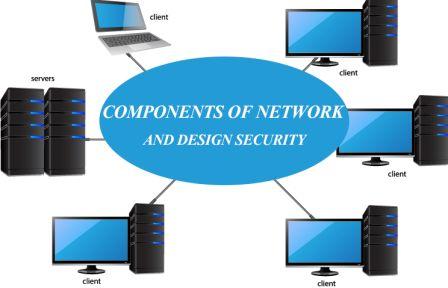The design and deployment of different enterprise networks are becoming pivotal issues of security concern.
Newer implementation of technology and innovation in enterprise mobility, cloud computing, and E-commerce need security as it is an excellent challenge in universal computing.
Components of the network Help in Security
Secured networks and organizations get security and safety from threats by implementing new technology. The design and implementation of secure systems prove functional for networking and design elements.
Today, the world is a global village. In this form of interconnected network, the system’s security is essential to protect the system from invaders and predators that can harm the confidential information and gain system access.
Different organizations and companies have to bear the massive cost of the negligence of security and face threats to their networking.
In the modern security system of administrators, it is essential to identify the significant differences between threats and harms for a corporate system network. Components of networks play a role under different technologies.
The net design’s security can help set up the secure network, NAT, subnetting, cloud computing, DMZ, and other elements.
Today, the world is emerging as a secure integrated network by the influence of computer systems. However, there is a strong need for system security. Company managers cater considerable expenses to manage their security networking.
Components of the network ensure the privacy of operations and provide sustainability for growth to attain the outcomes.
Components of Network and Design Elements
Different companies need security maintenance, and managers strive to adopt better security policies. These can define safe procedures for their users and networking. The security solution is helpful to defend the users and protect the company from harm.
The essential security solution in network components includes setting up elements that enhance security, such as perimeter network boundaries. It is helpful to differentiate between internet, intranet, and private networking systems.
Read the critical components of the network below:
Subnetting
It is a technology that provides a secure networking setup because it offers a system of security that offers flexible and minor elements. It is a subnet because it is acquired from nodes of the host and joined into a network mask that creates a subnet mask.
Since there is no need to secure the network by building other broadcast domains and through the control of traffic. This system of sub-netting is significant in enhancing IP address efficiency.
Demilitarized Zone (DMZ)
It is a demilitarized zone (DMZ) that appears ass established among firewalls yet allows access to a subnet that iexternal network resources.
This component of the network protects the web servers from outside traffic. This security system is helpful to any organization that needs to put it in public service safety as an extra layer of protection.
Network Address Translation (NAT)
It is network address translation (NAT). It is a mechanism that allows only private internet protocol addresses rooted in a mistrusted public networking system. The server can adopt this security measure by hiding the network from external users, and only limited IP addresses will be shown to the connected systems.
So, through NAT, IP addresses are assigned to the network hosts and devices because they can track incoming and outgoing traffic. Another super advantage of this method is that it can hide IP addresses from unauthorized users as a private system as long as the NAT is enabled.
Remote Access
To strengthen the security, remote access is another component of the security system. The remote access service allows remote networks such as VPN, DSL, and networking to be only accompanied by these systems.
Remote administration is an excellent kind of remote access service. It caters to the remote control of the user system. Therefore, based on the protocol type, the remote connection is established precisely and securely.
The network administrator sets up the remote access under manual startup service that needs application launch. It will also work when backdoor access to the network is stopped.
Network Access Control (NAC)
Network access control (NAC) provides standards that ensure the security of system operations and networking.
It can identify and define the client requirements before the networking access. In other words, this technique controls unauthorized access to the wired or wireless networking system.
This is mainly used to assess the posture in combination with credential-based security to block the device logged in to the system. This component of the network is critical to access control.
Virtualization
Under the process of virtualization, the development of virtual resources is accompanied by the development of actual resources. The virtual machine manager, the, i.e., hypervisor, relates to the existing hardware and helps to acquire the abstraction process.
This technology provides security benefits and caters to tampering with any virtual resources. They can be recovered and fixed easily when taken down to monitor the line.
Port Address Translation (PAT)
Port address translation (PAT) is a limited kind of NAT. Under the NAT system, several public networks become helpful, but PAT can only address the network spot and can also share it.
PAT is capable of offering the host networking system that relates to the IP address of the router.
The administrator specifies this element with TCP or UDP because it provides a limited option that can be best for the smaller networks.
The network security design offers specific solutions for system security and networking safety. Usually, these bottlenecks are attributable to existing network security systems and different implications of current 5G technology.
Therefore, the consequences of this technology involve the design components. They can help in the research process of secure networks and mobile systems.
There are sufficient vital areas that can help a company and organization to get security and safety. However, the critical areas of research, limitations, and challenges also exist, and there is a scope for future research on every aspect.
Security of Organizations
The vulnerabilities in mobile networking systems can improve due to improvements in technology frameworks in the preceding generations.
There is still an issue of backward compatibility related to the attack vectors. It is also attributable to the downgrade attacks while these vulnerabilities share the status of recurring.
The downgrade threats are due to wireless channels, unauthorized traffic, and unsecured pre-authentication traffic. Several cryptographic and protocol change techniques can help overcome this unsecured pre-authentication issue.
With better innovation and sophisticated change in security implementation, security against attackers can be improved.
It can also work against attacks in jamming related to the wireless protocol’s openness and related issues.
So, future research should address the downgrade attack category to eliminate such significant problems.
Lastly, a secure network is critical to any organization.
Its design elements are the essential security measures that can provide security administrators. Managers for the organization who can work to ensure fruitful performance and employ critical strategies to eliminate such issues.
These efforts are helpful for the efficacy of the organization.

